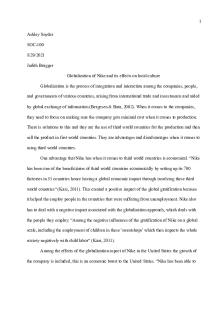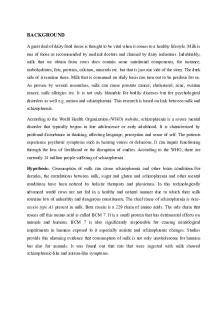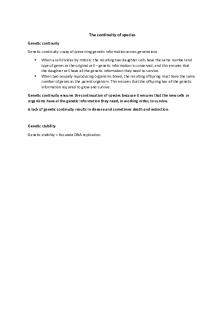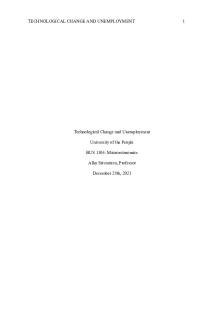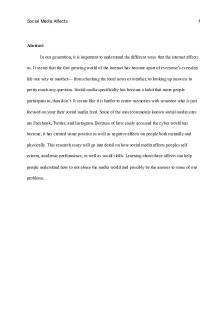Globalization of Nike and its effects on local culture-ASH PDF

| Title | Globalization of Nike and its effects on local culture-ASH |
|---|---|
| Author | Ashley Snyder |
| Course | Everyday Sociology |
| Institution | Grand Canyon University |
| Pages | 3 |
| File Size | 62.3 KB |
| File Type | |
| Total Downloads | 78 |
| Total Views | 149 |
Summary
Essay on Globalization and its effects on local culture...
Description
1 Ashley Snyder SOC-100 8/29/2021 Judith Bragger Globalization of Nike and its effects on local culture Globalization is the process of integration and interaction among the companies, people, and governments of various countries, arising from international trade and investments and aided by global exchange of information (Bergesen & Bata, 2002). When it comes to the companies, they need to focus on making sure the company gets minimal cost when it comes to production. There is solutions to this and they are the use of third world countries for the production and then sell the product in first world countries. They are advantages and disadvantages when it comes to using third world countries. One advantage that Nike has when it comes to third world countries is economical. “Nike has been one of the beneficiaries of third world countries economically by setting up its 700 factories in 51 countries hence having a global economic impact through involving these third world countries” (Kazi, 2011). This created a positive impact of the global gratification because it helped the employ people in the countries that were suffering from unemployment. Nike also has to deal with a negative impact associated with the globalization approach, which deals with the people they employ. “Among the negative influences of the gratification of Nike on a global scale, including the employment of children in these 'sweatshops' which then impacts the whole society negatively with child labor” (Kazi, 2011). Among the effects of the globalization aspect of Nike in the United States the growth of the company is included, this is an economic boost to the United States. “Nike has been able to
2 hire most of the employees in the United States of America, with most jobs coming from Americans within positions such as logistics, laboratories, management, and administration” (Kazi, 2011). This has a major impact on the country economically not only because of paying taxes but through getting Americans jobs. However when there is a positive effect there is always a negative one. There is a negative influence associated with the gratification in the United States of America and it has to do with employment and imperialism. There is a negative effect because a lot of the US’s product is moved into third world countries. This causes a reduces in the number of employees who are deployed from other countries. Imperialism is something that happens in this situation. Imperialism is what is going on because there is more income from the production process which makes the employees in third world countries require less pay. Looking at both ends of the spectrum the United States is the losing party. The reason the United States would be the losing party is because it they don’t make up a big part in production but only in the process of consumption. “The third world countries gain a lot from the process of growth, but it’s still unethical since the employees are underpaid” (Baker, 2016). So that would mean that the biggest winner is Nike, the reason this is, is because Nike gain a bunch from the United States as consumers because they pay higher than the standard price. They also gain from the third world countries that because they provide cheap labor. To put into simpler words, Nike gets to gain a major amount from the process of globalization. However the process does have major impacts on both the local cultures because of the cheap labor and the United States providing the consumers. Nike gains from the process and becomes the receiver because of the cheap labor and an open market which makes them the winner and the United States the loser.
3 References Baker, M. (2016). Nike and child labor – how it went from laggard to leader.http://mallenbaker.net/article/clear-reflection/nike-and-child-labour-how-it- went from-laggard-to-leader Bergesen, A., & Michelle, M. (2002, February 26). Global and National Inequality: Are They Connected? | Journal of World-Systems Research. Journal of World-Systems Research. https://jwsr.pitt.edu/ojs/jwsr/article/view/277 Kazi, T. (2011). Superbrands, Globalization, and Neoliberalism: Exploring Causes and Consequences of the Nike Superbrand. Student Pulse, 3(12)....
Similar Free PDFs

Oc spray and its effects
- 3 Pages

Roberson and Ritzer on Globalization
- 16 Pages

Effects of internet on society
- 3 Pages

Effects Of Sitcoms On Teenagers
- 6 Pages

Nike on Twitter
- 4 Pages

Pros and cons of globalization
- 5 Pages
Popular Institutions
- Tinajero National High School - Annex
- Politeknik Caltex Riau
- Yokohama City University
- SGT University
- University of Al-Qadisiyah
- Divine Word College of Vigan
- Techniek College Rotterdam
- Universidade de Santiago
- Universiti Teknologi MARA Cawangan Johor Kampus Pasir Gudang
- Poltekkes Kemenkes Yogyakarta
- Baguio City National High School
- Colegio san marcos
- preparatoria uno
- Centro de Bachillerato Tecnológico Industrial y de Servicios No. 107
- Dalian Maritime University
- Quang Trung Secondary School
- Colegio Tecnológico en Informática
- Corporación Regional de Educación Superior
- Grupo CEDVA
- Dar Al Uloom University
- Centro de Estudios Preuniversitarios de la Universidad Nacional de Ingeniería
- 上智大学
- Aakash International School, Nuna Majara
- San Felipe Neri Catholic School
- Kang Chiao International School - New Taipei City
- Misamis Occidental National High School
- Institución Educativa Escuela Normal Juan Ladrilleros
- Kolehiyo ng Pantukan
- Batanes State College
- Instituto Continental
- Sekolah Menengah Kejuruan Kesehatan Kaltara (Tarakan)
- Colegio de La Inmaculada Concepcion - Cebu
